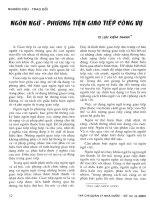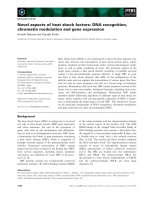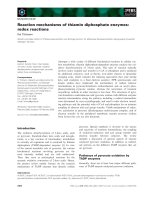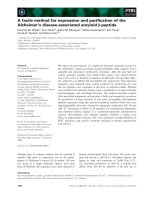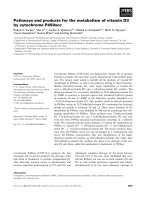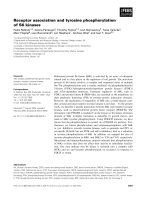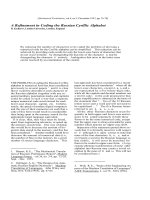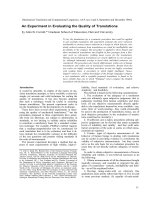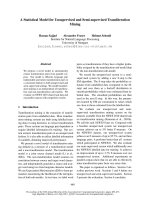Tài liệu Báo cáo khoa học: "Mining Wiki Resources for Multilingual Named Entity Recognition" pdf
Bạn đang xem bản rút gọn của tài liệu. Xem và tải ngay bản đầy đủ của tài liệu tại đây (137.36 KB, 9 trang )
Proceedings of ACL-08: HLT, pages 1–9,
Columbus, Ohio, USA, June 2008.
c
2008 Association for Computational Linguistics
Mining Wiki Resources for Multilingual Named Entity Recognition
Alexander E. Richman
Patrick Schone
Department of Defense Department of Defense
Washington, DC 20310 Fort George G. Meade, MD 20755
Abstract
In this paper, we describe a system by which
the multilingual characteristics of Wikipedia
can be utilized to annotate a large corpus of
text with Named Entity Recognition (NER)
tags requiring minimal human intervention
and no linguistic expertise. This process,
though of value in languages for which
resources exist, is particularly useful for less
commonly taught languages. We show how
the Wikipedia format can be used to identify
possible named entities and discuss in detail
the process by which we use the Category
structure inherent to Wikipedia to determine
the named entity type of a proposed entity.
We further describe the methods by which
English language data can be used to
bootstrap the NER process in other languages.
We demonstrate the system by using the
generated corpus as training sets for a variant
of BBN's Identifinder in French, Ukrainian,
Spanish, Polish, Russian, and Portuguese,
achieving overall F-scores as high as 84.7%
on independent, human-annotated corpora,
comparable to a system trained on up to
40,000 words of human-annotated newswire.
1 Introduction
Named Entity Recognition (NER) has long been a
major task of natural language processing. Most of
the research in the field has been restricted to a few
languages and almost all methods require substan-
tial linguistic expertise, whether creating a rule-
based technique specific to a language or manually
annotating a body of text to be used as a training
set for a statistical engine or machine learning.
In this paper, we focus on using the multilingual
Wikipedia (wikipedia.org) to automatically create
an annotated corpus of text in any given language,
with no linguistic expertise required on the part of
the user at run-time (and only English knowledge
required during development). The expectation is
that for any language in which Wikipedia is
sufficiently well-developed, a usable set of training
data can be obtained with minimal human
intervention. As Wikipedia is constantly
expanding, it follows that the derived models are
continually improved and that increasingly many
languages can be usefully modeled by this method.
In order to make sure that the process is as
language-independent as possible, we declined to
make use of any non-English linguistic resources
outside of the Wikimedia domain (specifically,
Wikipedia and the English language Wiktionary
(en.wiktionary.org)). In particular, we did not use
any semantic resources such as WordNet or part of
speech taggers. We used our automatically anno-
tated corpus along with an internally modified
variant of BBN's IdentiFinder (Bikel et al., 1999),
specifically modified to emphasize fast text
processing, called “PhoenixIDF,” to create several
language models that could be tested outside of the
Wikipedia framework. We built on top of an
existing system, and left existing lists and tables
intact. Depending on language, we evaluated our
derived models against human or machine
annotated data sets to test the system.
2 Wikipedia
2.1 Structure
Wikipedia is a multilingual, collaborative encyclo-
pedia on the Web which is freely available for re-
search purposes. As of October 2007, there were
over 2 million articles in English, with versions
available in 250 languages. This includes 30 lan-
guages with at least 50,000 articles and another 40
with at least 10,000 articles. Each language is
available for download (download.wikimedia.org)
in a text format suitable for inclusion in a database.
For the remainder of this paper, we refer to this
format.
1
Within Wikipedia, we take advantage of five
major features:
•
Article links, links from one article to another
of the same language;
•
Category links, links from an article to special
“Category” pages;
•
Interwiki links, links from an article to a
presumably equivalent, article in another
language;
•
Redirect pages, short pages which often
provide equivalent names for an entity; and
•
Disambiguation pages, a page with little
content that links to multiple similarly named
articles.
The first three types are collectively referred to as
wikilinks.
A typical sentence in the database format looks
like the following:
“Nescopeck Creek is a [[tributary]] of the [[North
Branch Susquehanna River]] in [[Luzerne County,
Pennsylvania|Luzerne County]].”
The double bracket is used to signify wikilinks. In
this snippet, there are three articles links to English
language Wikipedia pages, titled “Tributary,”
“North Branch Susquehanna River,” and “Luzerne
County, Pennsylvania.” Notice that in the last link,
the phrase preceding the vertical bar is the name of
the article, while the following phrase is what is
actually displayed to a visitor of the webpage.
Near the end of the same article, we find the
following representations of Category links:
[[Category:Luzerne County, Pennsylvania]],
[[Category:Rivers of Pennsylvania]], {{Pennsyl-
vania-geo-stub}}. The first two are direct links to
Category pages. The third is a link to a Template,
which (among other things) links the article to
“Category:Pennsylvania geography stubs”. We
will typically say that a given entity belongs to
those categories to which it is linked in these ways.
The last major type of wikilink is the link be-
tween different languages. For example, in the
Turkish language article “Kanuni Sultan Süley-
man” one finds a set of links including [[en:Sulei-
man the Magnificent]] and [[ru:Сулейман I]].
These represent links to the English language
article “Suleiman the Magnificent” and the Russian
language article “Сулейман I.” In almost all
cases, the articles linked in this manner represent
articles on the same subject.
A redirect page is a short entry whose sole pur-
pose is to direct a query to the proper page. There
are a few reasons that redirect pages exist, but the
primary purpose is exemplified by the fact that
“USA” is an entry which redirects the user to the
page entitled “United States.” That is, in the vast
majority of cases, redirect pages provide another
name for an entity.
A disambiguation page is a special article
which contains little content but typically lists a
number of entries which might be what the user
was seeking. For instance, the page “Franklin”
contains 70 links, including the singer “Aretha
Franklin,” the town “Franklin, Virginia,” the
“Franklin River” in Tasmania, and the cartoon
character “Franklin (Peanuts).” Most disambigua-
tion pages are in Category:Disambiguation or one
of its subcategories.
2.2 Related Studies
Wikipedia has been the subject of a considerable
amount of research in recent years including
Gabrilovich and Markovitch (2007), Strube and
Ponzetto (2006), Milne et al. (2006), Zesch et al.
(2007), and Weale (2007). The most relevant to
our work are Kazama and Torisawa (2007), Toral
and Muñoz (2006), and Cucerzan (2007). More
details follow, but it is worth noting that all known
prior results are fundamentally monolingual, often
developing algorithms that can be adapted to other
languages pending availability of the appropriate
semantic resource. In this paper, we emphasize the
use of links between articles of different languages,
specifically between English (the largest and best
linked Wikipedia) and other languages.
Toral and Muñoz (2006) used Wikipedia to cre-
ate lists of named entities. They used the first
sentence of Wikipedia articles as likely definitions
of the article titles, and used them to attempt to
classify the titles as people, locations, organiza-
tions, or none. Unlike the method presented in this
paper, their algorithm relied on WordNet (or an
equivalent resource in another language). The au-
thors noted that their results would need to pass a
manual supervision step before being useful for the
NER task, and thus did not evaluate their results in
the context of a full NER system.
Similarly, Kazama and Torisawa (2007) used
Wikipedia, particularly the first sentence of each
article, to create lists of entities. Rather than
building entity dictionaries associating words and
2
phrases to the classical NER tags (PERSON, LO-
CATION, etc.) they used a noun phrase following
forms of the verb “to be” to derive a label. For ex-
ample, they used the sentence “Franz Fischler is
an Austrian politician” to associate the label “poli-
tician” to the surface form “Franz Fischler.” They
proceeded to show that the dictionaries generated
by their method are useful when integrated into an
NER system. We note that their technique relies
upon a part of speech tagger, and thus was not ap-
propriate for inclusion as part of our non-English
system.
Cucerzan (2007), by contrast to the above,
used Wikipedia primarily for Named Entity Dis-
ambiguation, following the path of Bunescu and
Paşca (2006). As in this paper, and unlike the
above mentioned works, Cucerzan made use of the
explicit Category information found within Wiki-
pedia. In particular, Category and related list-
derived data were key pieces of information used
to differentiate between various meanings of an
ambiguous surface form. Unlike in this paper,
Cucerzan did not make use of the Category infor-
mation to identify a given entity as a member of
any particular class. We also note that the NER
component was not the focus of the research, and
was specific to the English language.
3 Training Data Generation
3.1 Initial Set-up and Overview
Our approach to multilingual NER is to pull back
the decision-making process to English whenever
possible, so that we could apply some level of lin-
guistic expertise. In particular, by focusing on
only one language, we could take maximum ad-
vantage of the Category structure, something very
difficult to do in the general multilingual case.
For computational feasibility, we downloaded
various language Wikipedias and the English lan-
guage Wiktionary in their text (.xml) format and
stored each language as a table within a single
MySQL database. We only stored the title, id
number, and body (the portion between the
<TEXT> and </TEXT> tags) of each article.
We elected to use the ACE Named Entity types
PERSON, GPE (Geo-Political Entities), OR-
GANIZATION, VEHICLE, WEAPON, LOCA-
TION, FACILITY, DATE, TIME, MONEY, and
PERCENT. Of course, if some of these types were
not marked in an existing corpus or not needed for
a given purpose, the system can easily be adapted.
Our goal was to automatically annotate the text
portion of a large number of non-English articles
with tags like <ENAMEX TYPE=“GPE”>Place
Name</ENAMEX> as used in MUC (Message
Understanding Conference). In order to do so, our
system first identifies words and phrases within the
text that might represent entities, primarily through
the use of wikilinks. The system then uses catego-
ry links and/or interwiki links to associate that
phrase with an English language phrase or set of
Categories. Finally, it determines the appropriate
type of the English language data and assumes that
the original phrase is of the same type.
In practice, the English language categorization
should be treated as one-time work, since it is
identical regardless of the language model being
built. It is also the only stage of development at
which we apply substantial linguistic knowledge,
even of English.
In the sections that follow, we begin by show-
ing how the English language categorization is
done. We go on to describe how individual non-
English phrases are associated with English lan-
guage information. Next, we explain how possible
entities are initially selected. Finally, we discuss
some optional steps as well as how and why they
could be used.
3.2 English Language Categorization
For each article title of interest (specifically ex-
cluding Template pages, Wikipedia admistrative
pages, and articles whose title begins with “List
of”), we extracted the categories to which that en-
try was assigned. Certainly, some of these cate-
gory assignments are much more useful than others
For instance, we would expect that any entry in
“Category:Living People” or “Category:British
Lawyers” will refer to a person while any entry in
“Category:Cities in Norway” will refer to a GPE.
On the other hand, some are entirely unhelpful,
such as “Category:1912 Establishments” which
includes articles on Fenway Park (a facility), the
Republic of China (a GPE), and the Better
Business Bureau (an organization). Other catego-
ries can reliably be used to determine that the
article does not refer to a named entity, such as
“Category:Endangered species.” We manually
derived a relatively small set of key phrases, the
most important of which are shown in Table 1.
3
Table 1: Some Useful Key Category Phrases
PERSON “People by”, “People in”, “People from”,
“Living people”, “births”, “deaths”, “by
occupation”, “Surname”, “Given names”,
“Biography stub”, “human names”
ORG
“Companies”, “Teams”, “Organizations”,
“Businesses”, “Media by”, “Political
parties”, “Clubs”, “Advocacy groups”,
“Unions”, “Corporations”, “Newspapers”,
“Agencies”, “Colleges”, “Universities” ,
“Legislatures”, “Company stub”, “Team
stub”, “University stub”, “Club stub”
GPE
“Cities”, “Countries”, “Territories”,
“Counties”, “Villages”, “Municipalities”,
“States” (not part of “United States”),
“Republics”, “Regions”, “Settlements”
DATE
“Days”, “Months”, “Years”, “Centuries”
NONE
“Lists”, “List of”, “Wars”, “Incidents”
For each article, we searched the category
hierarchy until a threshold of reliability was passed
or we had reached a preset limit on how far we
would search.
For example, when the system tries to classify
“Jacqueline Bhabha,” it extracts the categories
“British Lawyers,” “Jewish American Writers,”
and “Indian Jews.” Though easily identifiable to a
human, none of these matched any of our key
phrases, so the system proceeded to extract the
second order categories “Lawyers by nationality,”
“British legal professionals,” “American writers by
ethnicity,” “Jewish writers,” “Indian people by
religion,” and “Indian people by ethnic or national
origin” among others. “People by” is on our key
phrase list, and the two occurrences passed our
threshold, and she was then correctly identified.
If an article is not classified by this method, we
check whether it is a disambiguation page (which
often are members solely of “Category:Disam-
biguation”). If it is, the links within are checked to
see whether there is a dominant type. For instance,
the page “Amanda Foreman” is a disambiguation
page, with each link on the page leading to an
easily classifiable article.
Finally, we use Wiktionary, an online colla-
borative dictionary, to eliminate some common
nouns. For example, “Tributary” is an entry in
Wikipedia which would be classified as a Location
if viewed solely by Category structure. However,
it is found as a common noun in Wiktionary, over-
ruling the category based result.
3.3 Multilingual Categorization
When attempting to categorize a non-English term
that has an entry in its language’s Wikipedia, we
use two techniques to make a decision based on
English language information. First, whenever
possible, we find the title of an associated English
language article by searching for a wikilink
beginning with “en:”. If such a title is found, then
we categorize the English article as shown in
Section 3.2, and decide that the non-English title is
of the same type as its English counterpart. We
note that links to/from English are the most
common interlingual wikilinks.
Of course, not all articles worldwide have Eng-
lish equivalents (or are linked to such even if they
do exist). In this case, we attempt to make a deci-
sion based on Category information, associating
the categories with their English equivalents, when
possible. Fortunately, many of the most useful
categories have equivalents in many languages.
For example, the Breton town of Erquy has a
substantial article in the French language Wikipe-
dia, but no article in English. The system proceeds
by determining that Erquy belongs to four French
language categories: “Catégorie:Commune des
Côtes-d'Armor,” “Catégorie:Ville portuaire de
France,” “Catégorie:Port de plaisance,” and
“Catégorie:Station balnéaire.” The system pro-
ceeds to associate these, respectively, with “Cate-
gory:Communes of Côtes-d'Armor,” UNKNOWN,
“Category:Marinas,” and “Category:Seaside re-
sorts” by looking in the French language pages of
each for wikilinks of the form [[en: ]].
The first is a subcategory of “Category:Cities,
towns and villages in France” and is thus easily
identified by the system as a category consisting of
entities of type GPE. The other two are ambiguous
categories (facility and organization elements in
addition to GPE). Erquy is then determined to be
a GPE by majority vote of useful categories.
We note that the second French category actu-
ally has a perfectly good English equivalent (Cate-
gory:Port cities and towns in France), but no one
has linked them as of this writing. We also note
that the ambiguous categories are much more
GPE-oriented in French. The system still makes
the correct decision despite these factors.
We do not go beyond the first level categories
or do any disambiguation in the non-English case.
Both are avenues for future improvement.
4
3.4 The Full System
To generate a set of training data in a given lan-
guage, we select a large number of articles from its
Wikipedia (50,000 or more is recommended, when
possible). We prepare the text by removing exter-
nal links, links to images, category and interlingual
links, as well as some formatting. The main pro-
cessing of each article takes place in several stages,
whose primary purposes are as follows:
•
The first pass uses the explicit article links
within the text.
•
We then search an associated English language
article, if available, for additional information.
•
A second pass checks for multi-word phrases
that exist as titles of Wikipedia articles.
•
We look for certain types of person and
organization instances.
•
We perform additional processing for
alphabetic or space-separated languages,
including a third pass looking for single word
Wikipedia titles.
•
We use regular expressions to locate additional
entities such as numeric dates.
In the first pass, we attempt to replace all wiki-
links with appropriate entity tags. We assume at
this stage that any phrase identified as an entity at
some point in the article will be an entity of the
same type throughout the article, since it is com-
mon for contributors to make the explicit link only
on the first occasion that it occurs. We also as-
sume that a phrase in a bold font within the first
100 characters is an equivalent form of the title of
the article as in this start of the article on Erquy:
“Erquy (Erge-ar-Mor en breton, Erqi en gallo)”.
The parenthetical notation gives alternate names in
the Breton and Gallo languages. (In Wiki database
format, bold font is indicated by three apostrophes
in succession.)
If the article has an English equivalent, we
search that article for wikilinked phrases as well,
on the assumption that both articles will refer to
many of the same entities. As the English lan-
guage Wikipedia is the largest, it frequently con-
tains explicit references to and articles on
secondary people and places mentioned, but not
linked, within a given non-English article. After
this point, the text to be annotated contains no
Wikipedia specific information or formatting.
In the second pass, we look for strings of 2 to 4
words which were not wikilinked but which have
Wikipedia entries of their own or are partial
matches to known people and organizations (i.e.
“Mary Washington” in an article that contains
“University of Mary Washington”). We require
that each such string contains something other than
a lower case letter (when a language does not use
capitalization, nothing in that writing system is
considered to be lower case for this purpose).
When a word is in more than one such phrase, the
longest match is used.
We then do some special case processing.
When an organization is followed by something in
parentheses such as <ENAMEX TYPE=“ORGAN-
IZATION”>Maktab al-Khadamāt</ENAMEX>
(MAK), we hypothesize that the text in the
parentheses is an alternate name of the organiza-
tion. We also looked for unmarked strings of the
form X.X. followed by a capitalized word, where
X represents any capital letter, and marked each
occurrence as a PERSON.
For space-separated or alphabetic languages,
we did some additional processing at this stage to
attempt to identify more names of people. Using a
list of names derived from Wiktionary (Appen-
dix:Names) and optionally a list derived from
Wikipedia (see Section 3.5.1), we mark possible
parts of names. When two or more are adjacent,
we mark the sequence as a PERSON. Also, we fill
in partial lists of names by assuming single non-
lower case words between marked names are actu-
ally parts of names themselves. That is, we would
replace <ENAMEX TYPE=“PERSON”>Fred
Smith</ENAMEX>, Somename <ENAMEX
TYPE=“PERSON”>Jones </ENAMEX> with
<ENAMEX TYPE=“PERSON”> Fred Smith</E-
NAMEX>, <ENAMEX TYPE= “PERSON”>
Somename Jones</ENAMEX>. At this point, we
performed a third pass through the article. We
marked all non-lower case single words which had
their own Wikipedia entry, were part of a known
person's name, or were part of a known
organization's name.
Afterwards, we used a series of simple, lan-
guage-neutral regular expressions to find addi-
tional TIME, PERCENT, and DATE entities such
as “05:30” and “12-07-05”. We also executed
code that included quantities of money within a
NUMEX tag, as in converting 500 <NUMEX
TYPE=“MONEY”>USD</NUMEX> into <NU-
MEX TYPE=“MONEY”>500 USD</NUMEX>.
5
3.5 Optional Processing
3.5.1 Recommended Additions
All of the above could be run with almost no un-
derstanding of the language being modeled
(knowing whether the language was space-sepa-
rated and whether it was alphabetic or character-
based were the only things used). However, for
most languages, we spent a small amount of time
(less than one hour) browsing Wikipedia pages to
improve performance in some areas.
We suggest compiling a small list of stop
words. For our purposes, the determiners and the
most common prepositions are sufficient, though a
longer list could be used for the purpose of com-
putational efficiency.
We also recommend compiling a list of number
words as well as compiling a list of currencies,
since they are not capitalized in many languages,
and may not be explicitly linked either. Many lan-
guages have a page on ISO 4217 which contains
all of the currency information, but the format
varies sufficiently from language to language to
make automatic extraction difficult. Together,
these allow phrases like this (taken from the
French Wikipedia) to be correctly marked in its
entirety as an entity of type MONEY: “25 millions
de dollars.”
If a language routinely uses honorifics such as
Mr. and Mrs., that information can also be found
quickly. Their use can lead to significant im-
provements in PERSON recognition.
During preprocessing, we typically collected a
list of people names automatically, using the entity
identification methods appropriate to titles of
Wikipedia articles. We then used these names
along with the Wiktionary derived list of names
during the main processing. This does introduce
some noise as the person identification is not per-
fect, but it ordinarily increases recall by more than
it reduces precision.
3.5.2 Language Dependent Additions
Our usual, language-neutral processing only
considers wikilinks within a single article when
determining the type of unlinked words and
phrases. For example, if an article included the
sentence “The [[Delaware River|Delaware]] forms
the boundary between [[Pennsylvania]] and [[New
Jersey]]”, our system makes the assumption that
every occurrence of the unlinked word “Delaware”
appearing in the same article is also referring to the
river and thus mark it as a LOCATION.
For some languages, we preferred an alternate
approach, best illustrated by an example: The
word “Washington” without context could refer to
(among others) a person, a GPE, or an organiza-
tion. We could work through all of the explicit
wikilinks in all articles (as a preprocessing step)
whose surface form is Washington and count the
number pointing to each. We could then decide
that every time the word Washington appears
without an explicit link, it should be marked as its
most common type. This is useful for the Slavic
languages, where the nominative form is typically
used as the title of Wikipedia articles, while other
cases appear frequently (and are rarely wikilinked).
At the same time, we can do a second type of
preprocessing which allows more surface forms to
be categorized. For instance, imagine that we were
in a Wikipedia with no article or redirect associ-
ated to “District of Columbia” but that someone
had made a wikilink of the form [[Washing-
ton|District of Columbia]]. We would then make
the assumption that for all articles, District of Co-
lumbia is of the same type as Washington.
For less developed wikipedias, this can be
helpful. For languages that have reasonably well
developed Wikipedias and where entities rarely, if
ever, change form for grammatical reasons (such
as French), this type of preprocessing is virtually
irrelevant. Worse, this processing is definitely not
recommended for languages that do not use capi-
talization because it is not unheard of for people to
include sections like: “The [[Union Station|train
station]] is located at ” which would cause the
phrase “train station” to be marked as a FACILITY
each time it occurred. Of course, even in lan-
guages with capitalization, “train station” would be
marked incorrectly in the article in which the
above was located, but the mistake would be iso-
lated, and should have minimal impact overall.
4 Evaluation and Results
After each data set was generated, we used the text
as a training set for input to PhoenixIDF. We had
three human annotated test sets, Spanish, French
and Ukrainian, consisting of newswire. When
human annotated sets were not available, we held
out more than 100,000 words of text generated by
our wiki-mining process to use as a test set. For the
above languages, we included wiki test sets for
6
comparison purposes. We will give our results as
F-scores in the Overall, DATE, GPE,
ORGANIZATION, and PERSON categories using
the scoring metric in (Bikel et. al, 1999). The
other ACE categories are much less common, and
contribute little to the overall score.
4.1 Spanish Language Evaluation
The Spanish Wikipedia is a substantial, well-de-
veloped Wikipedia, consisting of more than
290,000 articles as of October 2007. We used two
test sets for comparison purposes. The first con-
sists of 25,000 words of human annotated news-
wire derived from the ACE 2007 test set, manually
modified to conform to our extended MUC-style
standards. The second consists of 335,000 words
of data generated by the Wiki process held-out
during training.
Table 2: Spanish Results
F (prec. / recall)
Newswire Wiki test set
ALL
.827 (.851 / .805)
.846 (.843 / .848)
DATE
.912 (.861 / .970)
.925 (.918 / .932)
GPE
.877 (.914 / .843)
.877 (.886 / .868)
ORG
.629 (.681 / .585)
.701 (.703 / .698)
PERSON
.906 (.921 / .892)
.821 (.810 / .833)
There are a few particularly interesting results
to note. First, because of the optional processing,
recall was boosted in the PERSON category at the
expense of precision. The fact that this category
scores higher against newswire than against the
wiki data suggests that the not-uncommon, but
isolated, occurrences of non-entities being marked
as PERSONs in training have little effect on the
overall system. Contrarily, we note that deletions
are the dominant source of error in the ORGANI-
ZATION category, as seen by the lower recall.
The better performance on the wiki set seems to
suggest that either Wikipedia is relatively poor in
Organizations or that PhoenixIDF underperforms
when identifying Organizations relative to other
categories or a combination.
An important question remains: “How do these
results compare to other methodologies?” In par-
ticular, while we can get these results for free, how
much work would traditional methods require to
achieve comparable results?
To attempt to answer this question, we trained
PhoenixIDF on additional ACE 2007 Spanish lan-
guage data converted to MUC-style tags, and
scored its performance using the same set of
newswire. Evidently, comparable performance to
our Wikipedia derived system requires between
20,000 and 40,000 words of human-annotated
newswire. It is worth noting that Wikipedia itself
is not newswire, so we do not have a perfect com-
parison.
Table 3: Traditional Training
~ Words of Training Overall F-score
3500 .746
10,000 .760
20,000
.807
40,000
.847
4.2 French Language Evaluation
The French Wikipedia is one of the largest
Wikipedias, containing more than 570,000 articles
as of October 2007. For this evaluation, we have
25,000 words of human annotated newswire
(Agence France Presse, 30 April and 1 May 1997)
covering diverse topics. We used 920,000 words
of Wiki-derived data for the second test.
Table 4: French Results
F (prec. / recall)
Newswire Wiki test set
ALL
.847 (.877 / .819)
.844 (.847 / .840)
DATE
.921 (.897 / .947)
.910 (.888 / .934)
GPE
.907 (.933 / .882)
.868 (.889 / .849)
ORG
.700 (.794 / .625)
.718 (.747 / .691)
PERSON
.880 (.874 / .885)
.823 (.818 / .827)
The overall results seem comparable to the Span-
ish, with the slightly better overall performance
likely correlated to the somewhat more developed
Wikipedia. We did not have sufficient quantities of
annotated data to run a test of the traditional meth-
ods, but Spanish and French are sufficiently similar
languages that we expect this model is comparable
to one created with about 40,000 words of human-
annotated data.
7
4.3 Ukrainian Language Evaluation
The Ukrainian Wikipedia is a medium-sized
Wikipedia with 74,000 articles as of October 2007.
Also, the typical article is shorter and less well-
linked to other articles than in the French or Span-
ish versions. Moreover, entities tend to appear in
many surface forms depending on case, leading us
to expect somewhat worse results. In the Ukrain-
ian case, the newswire consisted of approximately
25,000 words from various online news sites cov-
ering primarily political topics. We also held out
around 395,000 words for testing. We were also
able to run a comparison test as in Spanish.
Table 5: Ukrainian Results
F (prec. / recall)
Newswire Wiki test set
ALL
.747 (.863 / .649)
.807 (.809 / .806)
DATE
.780 (.759 / .803)
.848 (.842 / .854)
GPE
.837 (.833 / .841)
.887 (.901 / .874)
ORG
.585 (.800 / .462)
.657 (.678 / .637)
PERSON
.764 (.899 / .664)
.690 (.675 / .706)
Table 6: Traditional Training
~ Words of Training Overall F-score
5000 .662
10,000 .692
15,000
.740
20,000
.761
The Ukrainian newswire contained a much higher
proportion of organizations than the French or
Spanish versions, contributing to the overall lower
score. The Ukrainian language Wikipedia itself
contains very few articles on organizations relative
to other types, so the distribution of entities of the
two test sets are quite different. We also see that
the Wiki-derived model performs comparably to a
model trained on 15-20,000 words of human-
annotated text.
4.4 Other Languages
For Portuguese, Russian, and Polish, we did not
have human annotated corpora available for test-
ing. In each case, at least 100,000 words were held
out from training to be used as a test set. It seems
safe to suppose that if suitable human-annotated
sets were available for testing, the PERSON score
would likely be higher, and the ORGANIZATION
score would likely be lower, while the DATE and
GPE scores would probably be comparable.
Table 7: Other Language Results
F-score
Polish Portuguese Russian
ALL .859 .804 .802
DATE
.891 .861 .822
GPE
.916 .826 .867
ORG
.785 .706 .712
PERSON
.836 .802 .751
5 Conclusions
In conclusion, we have demonstrated that Wikipe-
dia can be used to create a Named Entity Recogni-
tion system with performance comparable to one
developed from 15-40,000 words of human-anno-
tated newswire, while not requiring any linguistic
expertise on the part of the user. This level of per-
formance, usable on its own for many purposes,
can likely be obtained currently in 20-40 lan-
guages, with the expectation that more languages
will become available, and that better models can
be developed, as Wikipedia grows.
Moreover, it seems clear that a Wikipedia-de-
rived system could be used as a supplement to
other systems for many more languages. In par-
ticular, we have, for all practical purposes, embed-
ded in our system an automatically generated
entity dictionary.
In the future, we would like to find a way to
automatically generate the list of key words and
phrases for useful English language categories.
This could implement the work of Kazama and
Torisawa, in particular. We also believe perform-
ance could be improved by using higher order non-
English categories and better disambiguation. We
could also experiment with introducing automati-
cally generated lists of entities into PhoenixIDF
directly. Lists of organizations might be parti-
cularly useful, and “List of” pages are common in
many languages.
8
References
Bikel, D., R. Schwartz, and R. Weischedel. 1999.
An algorithm that learns what's in a name. Ma-
chine Learning, 211-31.
Bunescu, R and M. Paşca. 2006. Using Encyclope-
dic knowledge for named entity disambigua-
tion. In Proceedings of EACL, 9-16.
Cucerzan, S. 2007. Large-scale named entity dis-
ambiguation based on Wikipedia data. In Pro-
ceedings of EMNLP/CoNLL, 708-16.
Gabrilovitch, E. and S. Markovitch. 2007. Com-
puting semantic relatedness using Wikipedia-
based explicit semantic analysis. In Proceed-
ings of IJCAI, 1606-11.
Gabrilovitch, E. and S. Markovitch. 2006. Over-
coming the brittleness bottleneck using
Wikipedia: enhancing text categorization with
encyclopedic knowledge. In Proceedings of
AAAI, 1301-06.
Gabrilovitch, E. and S. Markovitch. 2005. Feature
generation for text categorization using world
knowledge. In Proceedings of IJCAI, 1048-53.
Kazama, J. and K. Torisawa. 2007. Exploiting
Wikipedia as external knowledge for named
entity recognition. In Proceedings of
EMNLP/CoNLL, 698-707.
Milne, D., O. Medelyan and I. Witten. 2006. Min-
ing domain-specific thesauri from Wikipedia: a
case study. Web Intelligence 2006, 442-48
Strube, M. and S. P. Ponzeto. 2006. WikiRelate!
Computing semantic relatedness using
Wikipedia. In Proceedings of AAAI, 1419-24.
Toral, A. and R. Muñoz. 2006. A proposal to
automatically build and maintain gazetteers for
named entity recognition by using Wikipedia.
In Proceedings of EACL, 56-61.
Weale, T. 2006. Using Wikipedia categories for
document classification. Ohio St. University,
preprint.
Zesch, T., I. Gurevych and M. Mühlhäuser. 2007.
Analyzing and accessing Wikipedia as a lexical
semantic resource. In Proceedings of GLDV,
213-21.
9
